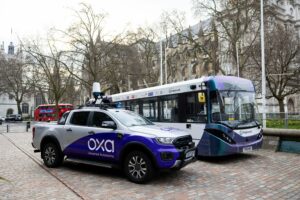
The event, held in London earlier this month, welcomed around 300 delegates and a vehicle display outside the venue included the automated bus from the CAVForth project.
This is the first automated bus route on public roads in the UK, carrying up to 10,000 passengers weekly on a 14-mile route from Fife to Edinburgh.
Also present was the Oxa Ford Ranger, showcasing latest CAV software and representing one of the many partnerships between vehicle and technology innovators that we can expect in the years ahead.
Mike Hawes, SMMT Chief Executive, opened the event with a speech that urged all parliamentarians to back the Automated Vehicles (AV) Bill and ensure its swift passage into law – so the UK can unlock the massive safety and economic benefits of self-driving passenger vehicles and public transport services.
Even if the current timetable is met, following the Bill’s second reading in the House of Commons in early March, the UK is unlikely to see self-driving vehicles on its roads until at least 2026.
But should the legislation be delayed until after the general election, that date is likely to be nearer to 2030 – putting the UK at a significant disadvantage.
“We have the foundations, but other major markets are stealing a march, with regulation already in place allowing them to benefit from UK-developed self-driving tech that cannot be rolled out here,” Hawes said.
“Any further delay risks leaving Britain in the slow lane, jeopardising our competitiveness and holding back the significant safety and economic rewards self-driving technology can deliver.
“More than £600m has already been committed to connected & self-driving vehicle testing & trialling. Our report suggests that implementing the tech in on-road passenger services, such as buses, taxis & ride-hailing, could deliver a market worth £3.7bn annually.”
Rival markets in the EU and US already have regulatory frameworks in place and may be taking the lead in this area, deploying the tech on public roads now – thus making the need for our own legislation even more urgent.
While the UK has firm foundations, thanks to government and industry jointly investing more than £600 million in self-driving vehicle trials since 2015, the risk is that the UK squanders its advantages.
Maria Cristina Galassi, Project Leader of Automated/Connected Vehicles and Safety at the EU Commission, talked about the importance of advancing and regulating connected, cooperative and automated mobility in Europe.
“We will have to collaborate internationally as vehicles will have to operate in different countries,” she said.
Automated driving technology, which reduces the risk of human error, could also save an additional 3,200 lives and prevent 53,000 serious accidents, from now until 2040, with a £38 billion economic boost for the taking.
Kevin Green, Director of Policy & Communications, at Logistics UK said: “Autonomy is a huge opportunity for larger commercial vehicles – it would be safer with fewer incidents, less downtime and less costly repairs – and also more productive, with reduced congestion and shorter journey times.”

He added: “The Automated Vehicles Bill provides a robust framework that brings clarity to investors, certainty to manufacturers, and confidence to the public.”
One of the sessions saw panelists discuss the key lessons and success factors from real-world commercial deployment of automated vehicles.
Peter Hafmar, Vice-President and Head of Autonomous Solutions, Scania Group, said that handling new tech is always challenging but historically the problem has been computing power.
He added: “Now it’s at a level equivalent to what we need. The tech isn’t the hindrance, it’s ready. The problem is legislation. We’re ready to go.”
UK consumers are often more enthusiastic about new technology than many in Europe, with government research also revealing that public interest in self-driving technology increases once consumers learn more about it.
Exclusive YouGov research commissioned by SMMT has found nearly a third of adults (29%) would use an automated bus, shuttle or taxi service if available today, with one in four (26%) likely to try self-driving features in a personal vehicle – even though they have yet to experience the technology.
For self-driving passenger services such as a bus, shuttle or taxi, consumers were most motivated by the prospect of lower fares, better availability in rural areas and safer journeys.
Existing technologies such as Adaptive Cruise Control and Park Assist, the most popular Advanced Driver Assistance Systems (ADAS) among survey respondents, are already making our roads safer.
One of the panelists, Maria Uvarova, SVP of Software Product at Stellantis, said: “We see how connectivity is important to our customers, but how do we make sure that customers trust a vehicle – that it is as safe as my own driving? This is the challenge.”
During one panel discussion, Dr René Hosse, Head of AD System Definition & Assurance, Volkswagen Commercial Vehicles talked about what can be done to overcome the remaining challenges to a safe and responsible commercial rollout of automated vehicles.
“We’re learning it’s not just about the driving system,” Dr Hosse said.

With some nine-in-10 road collisions caused by driver error, the potential of new fully automated features to reduce the risk of accidents and casualties on Britain’s roads is self-evident.
Now it is the turn of the politicians to make it a reality.








